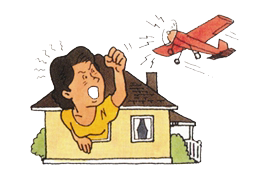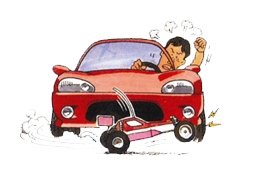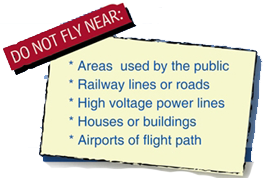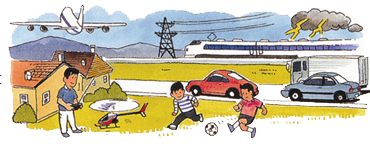GUIDE & SAFETY
GETTING STARTED IN THE HOBBY
"A hobby with plenty of involvement"
Operating a radio control models is not difficult, but if you are a newcomer/beginner to the hobby you will need to learn about new and unfamiliar techniques and equipments. Friendly staff of Hobby Centre will be able to give you advice on the type of model most suitable for your interest and budget and will either be able to supply what you need from stock or be able to order it for you. Also, you can contact directly Hobby Centre Technical Support Group or other modelers for advice on building and operating models and for assistance when you have your models ready to go.
SUPPLIES AND EQUIPMENT
Each modeler has his/her own favorite type of model, but you will need some basic equipment and materials no matter what type you choose. The first requirement is a model (the model car/plane/helicopter/boat/ jet) to build, the equipment to operate it – a radio control set, tools for building and operating the model – and a place to work, even if it's just a kitchen table.
RADIO CONTROL SYSTEM
When you bought a model, a radio control system designated for the model might be required to be purchased separately which is then installed into the model. Most predominant radio control systems are the FASS Test 2.4 GHz. Technology (Futaba Advance Spread Spectrum Technology). The radio control system consists of a transmitter which is to be operated by a modeler, a receiver and servos which are mounted into the model. The radio controlled car is basically designed to be controlled in two ways, speed control and steering control. Therefore, a two channel radio control system is to be employed.
- TRANSMITTER
Your transmitter serves as the control box for your R/C models. The standard transmitter uses control sticks, while a wheel and trigger type was developed for car models. When transmitter is in operation, it emits signals by means of radio waves.
- RECEIVER
The receiver accepts signals from the transmitter and converts them into pulses that operate the model's servo.
- SERVO
The servos get the electrical impulses from the receiver and convert them into mechanical movements. The servo motor then rotates an arm (servo horn) in a programmed direction. This movement then controls a specific model function; such as steering, acceleration/speed, aileron, elevator, rudder, etc.
- POWER SOURCE FOR RC SYSTEMS
Normally, twelve (12) AA size batteries are required to operate an R/C system. Four to eight (4 to 8) in the transmitter and four (4) for the receiver. Today, most of the hobbyists are using Li- Po (Lithium Polymer) transmitter and receiver batteries as it assures more power and flying time.
Basic Guide for enjoyment of your model
Choosing Running or Flying Area. Being considerate, doubles the fun

Never near houses or crowd of people!
The sound of model engines can be annoying to uninterested people. Always consider.
Never near overhead power lines!
Interference with radio signal is a possibility. A model cutting a power line would result in a serious incident.
Never near children!
Be extremely careful of unexpected movement of children or infant. Do not allow children to get to close to an R/C model.


Never on public road!
Using an R/C car helicopter or airplane on a public road can result in serious unexpected accident.


Flying field & safety!
When you are flying a model airplane/helicopter, you must think safety at all the times-both for yourself and others-as only you can control exactly where the models flies. Always chose designated flying fields which are allowed by law and rules of your flying country. Make sure that the area around the flying field is clear of people and property that could be damaged in the even of crash for at least a kilometer (over a half of a mile). When you learning to fly in strong winds, as turbulent conditions will make your model harder to control. Always take off and land into the wind.
Warning/guideline for li-po (Lithium Polymer) battery users

Lithium batteries are becoming very popular for powering the control and power systems in our models. This is true because of their very high energy density (amp-hrs/wt. ratio) compared to NiCad's or other batteries. With high energy comes increased risk in their use. The principal risk is FIRE which can result from improper charging, crash/damage, or shorting the batteries.
The following is recommended:
- Store, and charge, in a fireproof container; never in your model.
- Charge in a protected area devoid of combustibles. Always stand watch over the charging process. Never leave the charging process unattended.
- In the event of damage from crashes, etc, carefully remove to a safe place for at least a half hour to observe. Physically damaged cells could erupt into flame and after sufficient time to ensure safety, should be discarded in accordance with the instructions which came with the batteries. Never attempt to charge a cell with physical damage, regardless of how slight.
- Always use chargers designed for the specific purpose, preferably having a fixed setting for your particular pack. Many fires occur in using selectable/adjustable chargers improperly set. Never attempt to charge Lithium cells with a charger which is not specifically designed for charging Lithium cells. Never use chargers designed for Nickel Cadmium batteries.
- Use charging systems that monitor and control the charge state of each cell in the pack. Unbalanced cells can lead to disaster if it permits overcharge of a single cell in the pack. If the batteries show any sign of swelling, discontinue charging and remove them to a safe place outside as they could erupt into flames.
- Most important: NEVER PLUG IN A BATTERY AND LEAVE IT TO CHARGE UNATTENDED OVERNIGHT. Serious fires have resulted from this practice.
- Do not attempt to make your own battery packs from individual cells.
© 2024 HobbyCentre Dubai | HobbyCentre Abu Dhabi All rights reserved.
Back to Top


